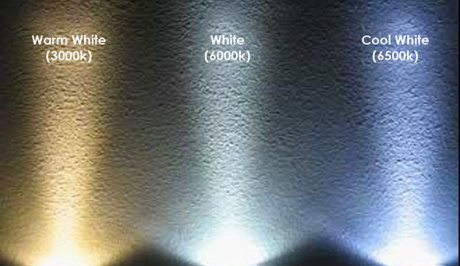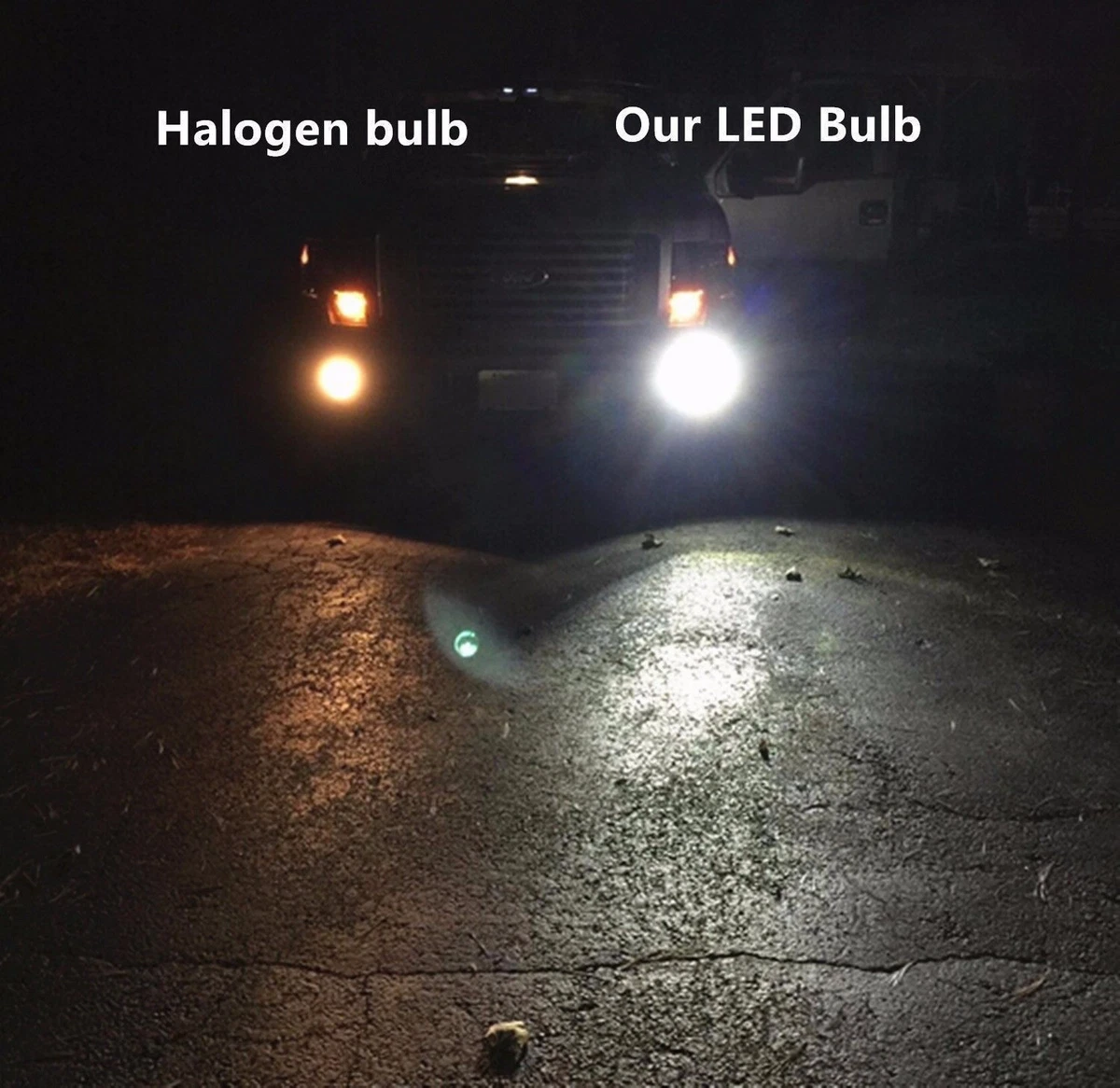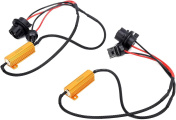
Headlights are one of the most important safety features in your vehicle. According to the US Department of Transportation, low visibility increases crash risk. Bad weather and the inability to see danger and react in time claim over 600 lives each year.
Seeing the obstacles and being seen by other drivers on the road increases the time slot for adequate reaction and improves safety. So, naturally, drivers look for brighter headlight bulbs. But intensity of light is not the only thing that matters for improved visibility.
The so-called color temperature plays a huge part in the way we perceive brightness. And the right headlight color temperature allows us to see clearly in poor weather conditions, does not create glare and is gentle to human eyes. That’s why 6000K headlight bulbs are so popular.
But with that logic, should not the 6500K bulbs be even better than 6000K? Let’s find out.

What Do 6000K & 6500K Mean?
Both 6000K and 6500K refer to the color temperature of your headlight bulbs or kelvins. These numbers indicate where the bulbs fall on the spectrum from warmer and dimmer orange to crisp blueish-white. The bigger this number is, the closer it feels to cold white light.
The human eyes favor light that is close to natural sunlight, around 5200K. They can pick up on details better in cold light, that’s why our offices and hospitals have fluorescent lights. But this color temperature also exhausts us a lot and damages our eyes after long exposure.
We perceive white light as more bright. But that alone is not enough to improve visibility in rough weather conditions. Yellow light can actually be more useful in fog or heavy rain since it creates less glare when it hits droplets of water suspended in midair.
Color Temperature Comparison Chart
|
Lighting Type |
Color Temperature Range |
|
Bright LED Headlights |
6000K - 6500K |
|
Daylight |
5200K |
|
Halogen Headlights |
4000K - 4500K |
|
Best Color Temperature for Human Eyes |
5700K - 6200K |
|
Automotive Fog Lighting |
3000K and 6500K |
|
Best Headlight Color Temperature for Night |
4000K - 5000K |
What Is The Difference Between 6000K vs 6500K?
The difference between 6000K and 6500K LED light is not very dramatic, but it is still noticeable to the human eye. Both options are really bright, especially compared to the humble 4000K – 4500K emitted by old halogen bulbs.
Let’s explore the subtle differences between these headlight color temperatures options:
1. Color
The higher the color temperature, the closer the light appears to cold tones. So, 6500K LEDs will look cooler than 6000K bulbs. A cooler tone brings forward more details than yellow. And despite it not being actually much brighter, we feel as if it was.
While the 6000K LED bulbs appear almost neutral white, their 6500K counterparts have more blue in them, and their light has a cold white hue. The difference is not so great, but for a trained eye, it is possible to notice.
You can definitely pick the color temperature that matches your vehicle’s paint without sacrificing much. After all, both 6000K and 6500K will provide great visibility in most conditions.
2. Performance in Fog
A lot of aftermarket and OE fog lights have a 6000K or 6500K color temperature. Wwhiter light tends to cut through water particles better. So, for this reason, 6500K bulbs are better because they are whiter.
The 6500K headlight bulbs will give you better visibility in fog than the 6000K bulbs. However, the lower intensity of 6000K bulbs makes them better at defining shapes and details.
3. Perceived Brightness
The 6500K LED headlight bulbs certainly look brighter. Their blue-white glow pierces through the air and illuminates the way a little better than the 6000K bulbs. Or so it looks like to our eyes.
4. Effect
The 6500K LEDs emit cooler light that helps us stay alert and awake. This harsh light stimulates our brain in a way bright daylight would do.
While the 6000K lack such an impact, they can be more tolerable to our sore eyes after a long day at work. Nighttime driving tires eyes and cool light can further irritate the sensitive organ.
5. Discrepancies
Different automotive headlight bulb manufacturers can rate their products differently. That is why you might encounter 6500K LED bulbs with an almost purple glow. This usually doesn’t happen to 6000K.
6. Cost Efficiency
If you are looking for the brightest headlight bulbs for a reasonable price, 6500K LED bulbs are the best choice. They cost less in production and provide excellent illumination of the road.
Although LED bulbs are not cheap, they make up for that with longevity. They last much longer than halogen bulbs and remain bright.
7. Compatibility
Human eyes are meant for natural sunlight. They have a hard time adjusting to abnormally bright cold light. That is why the 6000K LEDs can be less tiring for your eyes than 6500K bulbs.
Sometimes less is more. So, if you often find yourself on the road at night with a long way to go, maybe you should tone it down with brightness. Instead of 6500K, get just 6000K to avoid fatigue.

Is 6500K Brighter Than 6000K?
You could say that 6500K LED headlight bulbs are brighter. They definitely have more intensity to pierce through fog and rain. And they illuminate the road ahead so much better compared to the yellow halogen headlights.
Their light glows cold, allowing you to perceive more details and shapes. It can also signal to your brain that the time for rest and sleep is not there yet. But at the same time, too much brightness will make your eyes sore and tired faster.
Blue and cold-white light is not so great for our eyes. But it is really effective in increasing visibility at night and in poor weather conditions alike.
Is There a Big Difference Between 6000K & 6500K?
If you put each bulb inside the headlight assemblies to compare, you will see the difference. Both 6000K and 6500K bulbs are great for illumination. They provide a high-quality “daylight” kind of glow.
The major difference between 6000K and 6500K lies mostly in color. As the name “color temperature” suggests, one bulb will have warmer radiance while the other will seem colder to us. This perception is an illusion. However, it does have a function.
Cold white light is typically produced by a 6500K LED headlight bulb looks brighter to our eyes. This kind of light helps us see further and clearer, even at night. Blueish-white light makes details sharper to us.
That being said, the difference is not groundbreaking at all. They are not so far apart on the color temperature spectrum to be very different. Both appear as bright white light.
Is 6500K Too Bright?
No, 6500K is not too bright for headlights. This color temperature allows you to see so much better at night or in difficult weather conditions than the older halogen bulbs. 6500K is close to the perfect color temperature range for human eyes.
This means you will hardly be able to find LED bulbs with a better balance of brightness and comfort for the eyes. So, if you are browsing the aftermarket headlight bulb market, you can pick the 6500K LEDs with confidence.
These bulbs will provide excellent illumination and improve your visibility by far. Just make sure your vehicle is compatible with LED headlights before you buy a conversion kit.
Is 6500K Light Good for Human Eyes?
6500K is almost perfect for human eyes when there is a need to see the obstacles far ahead of your vehicle in trying conditions. It is believed to still be in the range of natural daylight our eyes are accustomed to.
The brightness of this cool-white light helps us stay awake and alert behind the wheel. However, as with any bright light, it can make our eyes tired. Drivers often complain about bright white headlights causing eye fatigue and even headaches.
Another important thing to consider is exposure. Long exposure to 6500K light from LED bulbs on a daily basis is not healthy. It can lead to more serious issues than sore eyes. Your retina is vulnerable, and you should protect your eyes from the headlights of the oncoming traffic and your own house lighting.

Is 6000K Good for LED Lights?
Actually, yes. The 6000K LED light is close to the perfect light range for human eyes. It looks more natural than 6500K because it has less blue in it. You could not call it a warm white, but it is definitely less cool and closer to neutral.
This lack of blue and yellow in its glow allows better color perception. Its brightness also works great whenever you need good illumination for work or driving. It makes details stand out and provides amazing visibility.
The color temperature is also great for low visibility due to weather conditions. Fog and rain can be less of a threat with 6000K or 6500K fog lights. This color temperature helps the light pierce water particles and light the way ahead.









Discussion